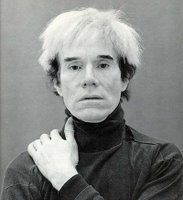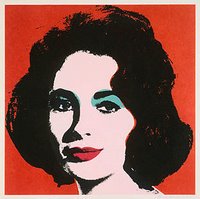 Andy Warhol born 6 August 1928 (d. 1987)
Andy Warhol born 6 August 1928 (d. 1987)Andrew Warhola, known as Andy Warhol, was an American artist of Slovak origin and a central figure in the movement known as pop art. After a successful career as a commercial illustrator, Warhol became famous worldwide for his work as a painter, an avant-garde film-maker, a record producer, an author, and a public figure known for his membership in wildly diverse social circles that included bohemian street people, distinguished intellectuals, Hollywood celebrities and wealthy aristocrats.
A controversial figure during his lifetime (his work was often derided by critics as a hoax, or 'put-on'), Warhol has been the subject of numerous retrospective exhibitions, books, feature and documentary films since his death in 1987.
Warhol coined the phrase 15 minutes of fame, which refers to the fleeting condition of celebrity that attaches to an object of media attention, then passes to some new object as soon as the public's attention span is exhausted.
 Warhol is best known for his extremely simple, larger-than-life, high-contrast colour paintings, silk-screen prints of packaged consumer products, everyday objects - such as Campbell's Soup cans, poppies and the banana appearing on the cover of the album The Velvet Underground and Nico (1967) - and for his stylised - and much pastiched - portraits of twentieth century celebrity icons - such as Marilyn Monroe, Elvis Presley, Jacqueline Kennedy Onassis and Elizabeth Taylor.
Warhol is best known for his extremely simple, larger-than-life, high-contrast colour paintings, silk-screen prints of packaged consumer products, everyday objects - such as Campbell's Soup cans, poppies and the banana appearing on the cover of the album The Velvet Underground and Nico (1967) - and for his stylised - and much pastiched - portraits of twentieth century celebrity icons - such as Marilyn Monroe, Elvis Presley, Jacqueline Kennedy Onassis and Elizabeth Taylor.He was also a highly influential and innovative film-maker, although his work, largely controlled by his estate and commercially unavailable, has been little seen in recent years.
In many of his efforts Warhol has taken the position of a producer or director, rather than a creator. From an artist he gradually became the person that determined the direction and was the public face of a company, having a staff of sorts to do the actual labour involved in his products. He would coin an idea and oversee its execution, his Factory evolved from an atelier into an office.
 In this respect Warhol talked about 'Art Business' and 'Business Art', and how he thought business was the best type of art. This was a radical new stance, as artists had always presented themselves as flamboyant, individual, visionary outsiders - commenting on the normal part of society, but never really being a part of it. And receiving appreciation for that position on the basis of their idealism, rare talents and personalities. Warhol and other pop-artists helped redefine the artist's position as professional, commercial, popular; a logical and valuable part of society. He did this using methods, imagery and talents that were (or at least seemed to be) available to everyone. Perhaps that has been the most meaningful result of (his) Pop Art: a philosophical and practical incorporation of art into society, art as a product of society.
In this respect Warhol talked about 'Art Business' and 'Business Art', and how he thought business was the best type of art. This was a radical new stance, as artists had always presented themselves as flamboyant, individual, visionary outsiders - commenting on the normal part of society, but never really being a part of it. And receiving appreciation for that position on the basis of their idealism, rare talents and personalities. Warhol and other pop-artists helped redefine the artist's position as professional, commercial, popular; a logical and valuable part of society. He did this using methods, imagery and talents that were (or at least seemed to be) available to everyone. Perhaps that has been the most meaningful result of (his) Pop Art: a philosophical and practical incorporation of art into society, art as a product of society. Warhol died in New York City from a routine gallbladder surgery at the age of 58. Warhol was afraid to enter hospitals and see doctors, so he had delayed having his recurring gallbladder problems checked.
Warhol died in New York City from a routine gallbladder surgery at the age of 58. Warhol was afraid to enter hospitals and see doctors, so he had delayed having his recurring gallbladder problems checked.Warhol was one of the first major homosexual American artists to be open about his sexuality. Many people think of Warhol as 'asexual' and merely a 'voyeur', but these notions have been debunked by biographers, explored by other members of the factory scene such as Bob Colacello (in his book Holy Terror: Andy Warhol Up Close), and by scholars. The question of how his sexuality informed Warhol's work and shaped his relationship to the art world is a major subject of scholarship on the artist, and is an issue that Warhol himself addressed in interviews, in conversation with his contemporaries, and in his publications.
 Throughout his career, Warhol produced erotic photography and drawings of male nudes. Many of his most famous works (portraits of Liza Minnelli, Judy Garland, Elizabeth Taylor, and films like My Hustler, Blow Job, and Lonesome Cowboys) draw from gay underground culture and/or openly explore the complexity of sexuality and desire. Many of his films premiered in gay porn theatres. That said, some stories about Warhol's development as an artist revolve around the obstacle his sexuality initially presented as he tried to launch his career. The first works that he submitted to a gallery in the pursuit of a career as an artist were homoerotic drawings of male nudes. They were rejected for being too openly gay.
Throughout his career, Warhol produced erotic photography and drawings of male nudes. Many of his most famous works (portraits of Liza Minnelli, Judy Garland, Elizabeth Taylor, and films like My Hustler, Blow Job, and Lonesome Cowboys) draw from gay underground culture and/or openly explore the complexity of sexuality and desire. Many of his films premiered in gay porn theatres. That said, some stories about Warhol's development as an artist revolve around the obstacle his sexuality initially presented as he tried to launch his career. The first works that he submitted to a gallery in the pursuit of a career as an artist were homoerotic drawings of male nudes. They were rejected for being too openly gay.To an extent, the evolution of his Pop style can be traced to the years when Warhol was first dismissed by the inner circles of the New York art world and thus created his own.
